Tarocco Bolognese: Ottocento
Ottocento is a Tarot game for 4 players which comes from Bologna. Tarot games have been played in that city for over 500 years, and the game of Ottocento as currently played preserves distinct characteristics (both of the games and of the pack of cards) which go back at least to the 16th century. The special 62-card pack that is used and the game itself are often known as Tarocchino (pronounced tarokino), the diminutive form of Tarocco referring to the reduction of the pack from 78 to 62 cards.
Ottocento is a point-trick game, with trumps. The cards have point values individually (as in other Tarot games) but also score in combinations. There is no bidding, but players can score by declaring card combinations held in their hands at the start of play, as well as for combinations taken in tricks.
Players
There are four players, two against two in fixed partnerships. Play is anticlockwise.
Cards
The pack is known as the Tarocco Bolognese - the version of the Tarot pack which has been used at Bologna since the 16th century. This pack is produced and sold by the main Italian playing-card manufacturers. It is somewhat similar to other Italian-suited Tarot packs, but omits the 2 to the 5 of each plain suit, and has other peculiarities found only at Bologna.
Players in North America can obtain Tarocco Bolognese cards from TaroBear's Lair.
Rank of Cards
There are 5 suits: 10 each of swords, batons, coins and cups and 21 trumps. One card, the Matto, belongs to no suit, making a total of 62 cards. The rank of the cards from hoghest to lowest is:
- in swords and batons: King, Queen, Knight, Jack, 10, 9, 8, 7, 6, Ace
- in cups and coins: King, Queen, Knight, Jack, Ace, 6, 7, 8, 9, 10
- in trumps: Angel (Angelo), World (Mondo), Sun
(Sole), Moon (Luna), 16, 15, 14, 13, 12, 11, 10, 9, 8, 7, 6, 5, the four Moors, Bégato
The Angel, World, Bégato and Matto are also known as the tarocchi.
The Matto has no rank and is played according to a special rule, see Play.
All the numbered trumps also have pictures on them, for instance the 16 is the Star, the 15 is the Tower, and so on, but the numbers are the simplest way to identify them.
In play the four Moors count equally (although they are not all visually identical - see below). If two or more Moors are played to a trick and no higher trump is played then the last Moor played wins.
(It is interesting to note in passing that this means there are 5 trumps ranked below the 5, and only 4 above the 16, so the numbers are not "correct". The most satisfying explanation of this is that the trump sequence was already established before the numbering was introduced and the numbers were chosen to retain the association of 13 with the death card).
Identification of Cards
At first sight, some of the cards in the pack may be hard to identify for those not familiar with them. In fact the pack is perfectly practical to play with (as 5 centuries of use have demonstrated), and after a little practice the designs are easy to recognise.
Numbered trumps: If there's a number on it then its a trump (whatever the picture may look like). In practice the most confusing one is the 8 of trumps (Justice) which shows a woman carrying some scales and a prominent sword, which might cause you to mistake it for a court card of the swords suit. You can tell it is in fact a trump from the fact that it has a figure 8 on it.
Unnumbered trumps: These are the most important cards in the pack: learn them and wake up if you see one!
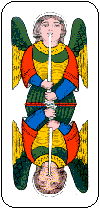 |
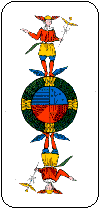 |
 |
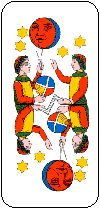 |
The top four trumps are the angel, the world, the sun and the moon. The angel blows a trumpet, the world is round, and the sun and the moon have fairly obvious pictures of these heavenly bodies. |
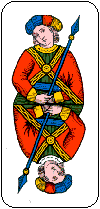 |
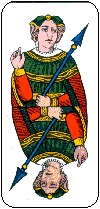 |
 |
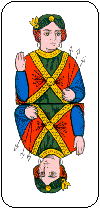 |
Immediately below the 5 of trumps come the four Moors. Two look the same, the other two look different, but all have equal rank during the play. |
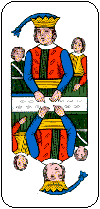 |
The Bégato is standing behind a table. He is the lowest trump, and is valuable as a counting card, as one of the tarocchi, and for his role in sequences. |
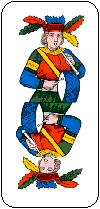 |
The Matto is not a trump. He beats nothing but a drum (see rules of play). |
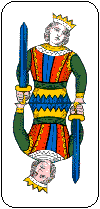 |
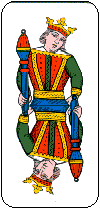 |
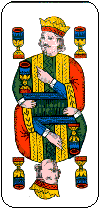 |
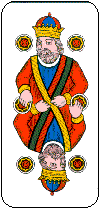 |
Here are the four Kings, of swords, batons, cups and coins. They all have crowns; two of them have beards, and the other two have their heads tilted to one side. |
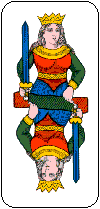 |
 |
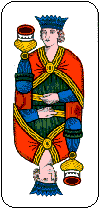 |
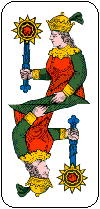 |
Here are the Queens of swords, batons, cups and coins. They have crowns and most of them look reasonably female |
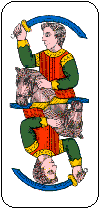 |
 |
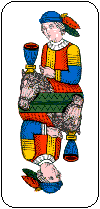 |
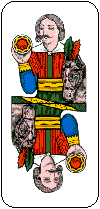 |
The Knights of swords, batons, cups and coins all ride horses. |
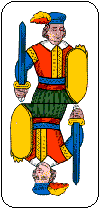 |
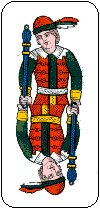 |
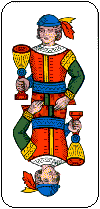 |
 |
The Jacks of swords, batons, cups and coins are the ones with no crowns and no horses |
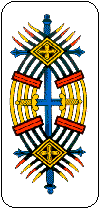 |
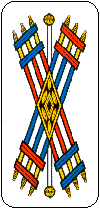 |
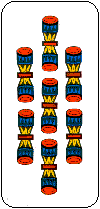 |
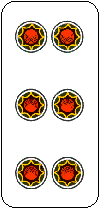 |
Here is a selection of pip cards. These can usually be identified by spotting the suit symbol and counting. Cups look rather like Christmas crackers. Swords on pip cards are curved while batons are straight; though most swords on court cards are straight. Swords and batons may have one or two symbols vertical or horizontal through the middle, separate from the other symbols. Illustrated here are the 10 of swords, 7 of batons, 7 of cups and 6 of coins. The 10 of swords has eight curved swords, a long straight vertical sword and a short straight horizontal sword. |
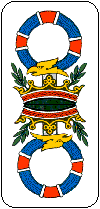 |
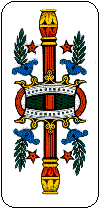 |
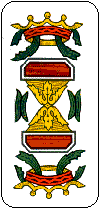 |
 |
Here are the aces of swords, batons, cups and coins. Note that the monochrome card with the blank circle is the ace of coins. The blank circle originally held the tax stamp but this is no longer required. The funny looking card with two circles connected by a bar is the ace of swords. The circle is actually the handle of the sword - the blade disappeared and the handle was duplicated when the cards were made double-ended. |
Card Points:
The basic values are as follows:
Tarocchi (Angel, World, Bégato, Matto) 5 each
Kings 5 each
Queens 4 each
Knights 3 each
Jacks 2 each
All other cards 1 each
In addition there are 6 points for the last trick.
Cards are counted in pairs, deducting one point from the value of each pair. (Because each trick contains 4 cards the number of cards captured by each side must always be even.) Of course this is the same as deducting half a point from each individual card value, so for instance a King is worth as much as 9 other
cards (4.5 to 0.5).
The total number of points in the pack, including the last trick, is 93.
Playing Procedure
The game is played anticlockwise. Partnerships remain fixed until a rubber is completed (800, hence Ottocento). The deal for the first hand of each rubber is decided randomly, after that the deal passes to the right after each hand.
The sequence of events on each deal is:
Deal
The dealer shuffles and gives the cards to the payer on his left to cut. The cards are then dealt out in packets of five cards, starting with the player on dealer's right. This means the dealer is left with 7 cards for himself at the end. Everyone picks up their cards and the dealer discards two cards to reduce his hand to the same number of cards (15) as everyone else. These cards count towards his side at the end of the hand as if they had been won in tricks (however they are lost if dealer's side loses every trick). Dealer may not discard 5-point cards (Tarocchi and Kings). He may discard other trumps (this differs from the custom in most other Tarot games).
Declarations
During the first trick, players may declare combinations of cards which have special scores: see Combinations. Note that the score is doubled only if three or more combinations of the same type are declared by the same player - it is not enough if the partnership declare three between them.
Each player makes any declarations he wishes to immediately before playing his card to the first trick. Combinations are declared by placing all the relevant cards face up on the table. After declaring, the player then plays to the first trick and picks up the cards displayed (if any); then the next player declares and plays, and so on.
Declarations are not compulsory, and it is even allowed to make a declaration which is less than the maximum possible - for instance to declare a sequence of 4 swords when 5 could be declared.
The dealer cannot include the cards that she discarded in declarations.
The Play
Any card may be led. Other players must follow suit if they can. If they have no cards of the suit led then they must play a trump. The trick is won by the highest card of the suit led, unless it contains a trump in which case the highest trump wins. The player to dealer's right leads to the first trick. Thereafter the winner of each trick leads to the next.
The Matto is an exception: it may be played to any trick regardless of whether or not the player has any cards in the suit led. When it is played, it is always retained by the side that played it. If the other side win the trick then the side that played it give them a worthless card in exchange. This can be any card they have previously taken in tricks, but if they have not yet taken any card of sufficient worthlessness they are allowed to wait until they do. In this case the Matto can be left face up as a reminder. Remember that many cards have some potential value, either in themselves or in combinations: usually a pip card from a suit is chosen to give in exchange, or a low numbered trump can be given once the trump sequence is known to be stopped (see Sequences). At the end of the hand, if no earlier, they must give a card in exchange; if they have taken no tricks at all then the Matto would be lost (this hardly ever happens).
If the Matto is ever led then the second player determines the
suit of the trick.
Signals
There are three signals which a player can make to her partner
at the same time as leading to a trick:
- volo: toss the card in the air: "This is my last card in this suit"
- busso: strike the table with the fist: "Please play your highest card and, if you win, return the same suit"
- striscio: scrape the card along the table: "Please lead trumps"
It is possible to make two signals at the same time. If volo is given without busso this would normally imply a request not to return the suit.
It is strictly forbidden to use any other signals (though there were many more in the nineteenth century). It is not compulsory for the partner to do as requested.
See Hints for some comments on when these signals could be used.
Combinations: Cricche and Sequences
Combinations can be scored in a player's hand at the start (see
Declarations) or at the end of the hand, in cards captured in tricks. In either case the scoring combinations are the same.
Cricche
These are combinations of three or four cards of a kind. Scoring
is:
All 4 cards Any 3 cards
Tarocchi (Angel, World, Bégato, Matto) 36 points 18 points
Kings 34 points 17 points
Queens 28 points 14 points
Knights 26 points 13 points
Jacks 24 points 12 points
If three or more different cricche are scored at the same
time (for instance 3 tarocchi, 4 kings and 3 jacks) then the total score for cricche is doubled.
Sequences
These are combinations of 3 or more cards and score according
to the number of cards in the sequence:
3 cards (minimum) 10 points
each additional card 5 points
If three or more different sequences are scored at the same time (for instance Swords, Aces and Moors) then the total score for sequences is doubled.
All sequences have a minimum condition to establish the sequence; once established, additional cards may be added under less restrictive conditions.
The Matto and Bégato are wild cards (contatori) which can be used in place of some of the cards which would normally be required in sequences. If not needed to establish the sequence they can always be added to the length (and hence the score), even if all possible "real" cards are already present. Each wild card held can be used in every sequence.
- Trump sequence:
- The Angel, which must be real (that is, it cannot be substituted by a wild card), and at least two of the next three trumps (World, Sun, Moon), at least one of which must be real. Once established, further trumps can be added in sequence from the 16 on down until there is a missing trump. Wild cards can be used in place of numbered trumps, and the sequence can continue, but:
- each wild card can be used only once in each sequence. In particular, if it has been used to replace the World, Sun or Moon it cannot be used again to replace a numbered trump.
- two adjacent wild cards end the sequence; they cannot be used cosecutively to fill two gaps in the middle of the sequence.
- Suit sequence:
- The King, which must be real, and at least two of the next three cards (Queen, Knight and Jack), at least one of which must be real. Once established, the ace can be added.
- Moors sequence:
- At least three Moors, at least two of which must be real.
- Aces sequence:
- At least three Aces, at least two of which must be real.
Examples:
- Angel, World, Moon, 16: trump sequence of 4, worth 15 points
- Angel, Matto (for the World or Sun), Moon, 16, 15, Bégato (for the 14), 13, 12: trump sequence of 8, worth 35 points. Note it is not necessary to replace both the World and the Sun with wild cards.
- Angel, World, Sun, Moon, 16, Matto, Bégato, 13: trump sequence of 7, worth 30 points. Note this is not a sequence of 8: both the 15 and the 14 are missing, the gap of two stops the sequence, and the 13 cannot be added.
- Angel, World, Bégato, Matto, 15, 14: trump sequence of 4, worth 15 points. The contatori can be counted, but they cannot be used to connect the 15 to the sequence, because one would have to represent the Sun or Moon and the other the 16, making them adjacent.
- Angel, Matto, Sun, Bégato, 15, 14: trump sequence of 6, worth 25 points. This differs from the above only in having the sum instead of the world. But now we can use the Matto to represent the world, separating the wild cards and enabling the 15 and 14 to be included in the sequence.
- King, Matto, Bégato, Ace: Not a sequence (at least one of the queen, knight, jack must be real)
- King, Knight, Jack: suit sequence of 3, worth 10 points
- King, Queen, Bégato (for Knight or Jack), Ace: suit sequence of 4, worth 15 points
- King, Queen, Knight, Jack, Ace, Matto: suit sequence of 6, worth 25 points.
- Two Moors, Bégato: sequence of 3, worth 10. Note that in this case the other side also holds a sequence of Moors: Two Moors and the Matto.
- Four Aces, Bégato, Matto: sequence of 6, worth 25 points
Scoring Procedure
The scoring in the present-day game is fairly complex (each hand ends by laying out most of one side's cards on the table) but is in fact a simplification of an earlier game which had another
level of scoring on top of the one which is used today.
As already stated, combinations announced during the first trick are scored at that time.
All other scoring is at the end of the hand: card points for cards captured, points for the last trick, and points for combinations of cards captured. The usual way of doing this is:
- take one side's pile of cards captured (including dealer's discard if this side were dealer) and lay them out on the table so as to show all the significant cards of each suit (Kings, Queens, Knights, Jacks, Aces, in a matrix of suit by rank), and all the significant trumps, and Moors. (It is best to choose the smaller pile of the two!).
- score for cricche. Do this first for the side whose cards are on the table and then for the other side (spotting the gaps: for instance if only one King is visible then the other
side must have a cricca of three Kings). Remember to double if three or more cricche are scored by a side.
- score for sequences. Do this first for the side whose cards are on the table and then for the other side (spotting the gaps). Remember to double if three or more sequences are scored by a
side.
- count the cards, putting one 1-point card on top of each 2- 3- 4- or 5- point card and scoring the value (see card points above), then counting the remaining 1-point cards in pairs, scoring 1 for each pair, and then adding 6 for the last trick
if this side won it. The other side's card points are then worked out by deducting from 93.
The rubber is won by the first side to reach 800. If both sides reach 800 on the same deal then the side that goes further beyond 800 wins. If one side goes beyond 800 during the declarations
during the first trick then they win immediately.
Hints
Alan Trangmar writes: The following represents my suggestions based on experience of playing the game in the UK, but I have not played the game in Bologna - and it is probable that no one outside Bologna is a really skilled player of Ottocento. So make up your own mind!
The first thing to notice is that the big swing on most hands is on sequences: if one side fails to reach 3 sequences then they lose by a big margin. The biggest influence on sequences is the wild cards, the Matto and Bégato, both of which also score in other ways. The Matto cannot be captured in play, but the Bégato can. Therefore the most important event in the play of the hand is capturing or saving the Bégato.
The player holding the Bégato will be thinking about the safest time to play it. If he has long trumps (say 7 or more) then there is no great urgency, a chance will probably appear. But if not, something may need to be done quickly. The safest way is to play it under partner's Angel - if they hold it. If the holder has a void or singleton it may be possible to use it to trump a side suit. This is satisfying (it may capture a King) but not entirely safe, especially if the dealer has yet to play to the trick (dealer often gives herself a void with the discard).
In this, as in all the play, players should remember the information they gained from the declarations on the first trick. If the partner is known to hold the Angel then it is safe just to lead the Bégato. If the only player yet to play to a trick in a side suit has shown cards in that suit (a sequence, or a card in a cricca) which they haven't yet played, then of course it is safe to play it.
If the holder of the Bégato knows or hopes his partner holds the King of a suit in which he has a singleton then he may lead the singleton and give the signals for 'this is my last card' and 'please win and return the same suit', hoping to be able to trump the second trick in the suit with the Bégato. But he must watch out for indications and be prepared to abandon the plan if he suspects the last player to play may also be void. For the same reason the partner should not return the suit if he holds too many cards in it: say more than 4.
With 10 cards between 4 players it is most common for the first round of a side suit not to be trumped (except possibly by dealer, who made a discard), and for the second round of a suit to be trumped by at most one player, but neither of these is certain! It is often useful to count the cards in a side suit to help estimate when other people will run out, but remember dealer's discard can throw out the calculation.
The other significant cards are the Kings, which are worth much more than the other side suit cards as they determine the suit-sequence as well as counting in cricche and being worth 5 points. The play in the side suits resembles other Tarot games. It is usually best not to lead away from a King. The compulsory trumping rule means that if a suit is going to go round (not be trumped) then it will do so however late in the hand it is played. If the suit is being trumped by an opponent then all is not lost, provided the King has not already been played: don't forget the Matto can be a way to avoid playing a King. One possibility is that this opponent may run out of trumps later in the hand. Or if the right hand opponent and partner are both trumping but the left hand opponent is not, it is often good to lead the King: it is lost if the right hand opponent holds the top trump, but otherwise they may play a high trump which can be captured by leader's partner. Other court cards can also usefully be led in this situation (but do count cards to avoid partner's high trump being captured by the left hand opponent suddenly trumping as well). But having said all that, if a suit is led and the player with the King does not hold too many cards in the suit (certainly up to 3, perhaps even with 4 or 5), the best chance is usually to play it on the first trick.
The Angel and Matto have a big effect on the score but cannot be captured in tricks. Other cards which can take part in sequences and cricche are all worth something. It is possible to keep a mental track of all the cards played in the hand, and know which side is trying to get each possible sequence, but this is not essential for beginners! In general every one of the significant cards will be worth something, either to add to one's own sequences or cricche or to deny them to the opponents. Don't get fixated by the Moors: they are interesting cards which are unique to the Taroccho Bolognese pack, and form a sequence which may be important, but they only score 1 card point each and (unlike Aces) don't normally contribute to any other sequence. Court cards are more valuable.
The trump sequence can be high-scoring. If a side believe the other side hold the bulk of the high trumps and also have one or both wild cards then they should aim to block the sequence; this is best done with the 16 and 15, or the highest numbered trumps which are held, which are more effective than the Sun or Moon. (The World is not very good at blocking the trump sequence but does take part in the cricca of tarocchi, and scores 5 points; anyway the holder of the World will usually be aiming to capture another big trump with it).
Players can make deductions from the declarations, as well as just observing the cards displayed. For instance a cricca of 3 Queens, apart from implying this player will not be trumping many suits on the first round, also implies that he probably does not hold the Queen of the fourth suit. Any sequence will normally have both wild cards added to it if they are held, so if they are not shown, they are probably not held. (In theory a player with the Bégato and very short trumps might make a declaration without adding the Bégato, to hide it; but she must remember her partner will remain ignorant and could start leading trumps!). And if three players are known not to hold the Bégato, the third must do so: remember dealer may not discard 5-point cards.
A player with a strong trump holding may lead trumps, and / or encourage their partner to do so (see Signals). This is particularly promising if they do not hold the Bégato, but can be generally useful in preventing the other side from trumping Kings or getting their scoring trumps home on tricks in side suits. Partner is not obliged to comply with a request to lead trumps but will normally do so if possible, unless they have a good reason not to: the strongest reason would be if they have the Bégato and short trumps - unless they know partner holds the Angel.
It is possible, as in other Tarot games, to persistently lead a long side suit to draw the other side's trumps. This can be sensible play, but be aware that it may allow them to save the Bégato without any difficulty, and allows them to choose which of their significant trumps to save. This strategy brings most benefits if the other side are leading trumps themselves.
Substitute Pack
If you cannot find a correct pack then it is theoretically possible to play the game with another Tarot pack, for instance a cut-down Tarot de Marseille or Tarocco Piemontese, but a number of subsitutions would have to be made in trumps:
- XX used for the Angel (highest trump)
- XXI for the World (note that the XX beats the XXI)
- XIX for the Sun
- XVIII for the Moon
- XVII for the 16 (!) (Star)
- ...
- VI for the 5
- V, IIII, III, II for the 4 Moors (replaced by popes and emperors)
- I for the Bégato
This is only recommended as a last resort since the individuality of the Bolognese cards is one of the attractions of the game.
Other Tarocco Bolognese WWW pages
Here is the web site of the Accademia del Tarocchino Bolognese - an institute devoted to the promotion and development of the game.
Maurizio Barilli's Tarocco Bolognese web site includes rules for Ottocento and for several closely related games, including versions for 2 or 3 players.
The card game encylopedia at tretre.it includes rules for Tarocchino Bolognese. At this site there is also the Biblioteca del tre, which has reproductions of several early books about Tarocchino, and a copy of the earliest known rules for Tarocchino, from a manuscript dating originally from the late 16th or early 17th century, and transcribed by Pedini in 1746.
COMMENTS








































